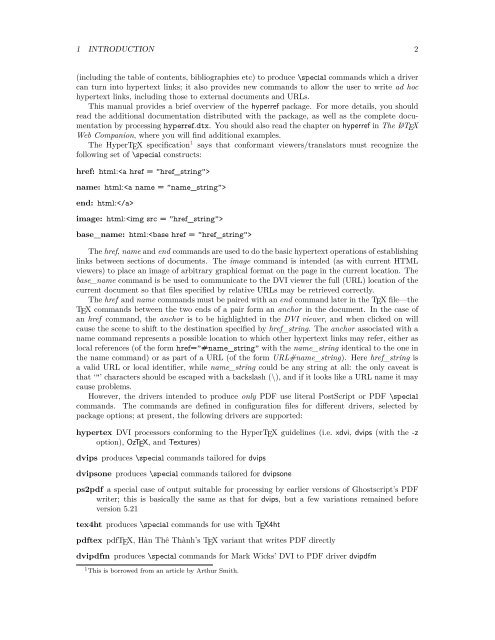Hypertext marks in LaTeX: a manual for hyperref - TUG
Hypertext marks in LaTeX: a manual for hyperref - TUG
Hypertext marks in LaTeX: a manual for hyperref - TUG
Create successful ePaper yourself
Turn your PDF publications into a flip-book with our unique Google optimized e-Paper software.
1 INTRODUCTION 2<br />
(<strong>in</strong>clud<strong>in</strong>g the table of contents, bibliographies etc) to produce \special commands which a driver<br />
can turn <strong>in</strong>to hypertext l<strong>in</strong>ks; it also provides new commands to allow the user to write ad hoc<br />
hypertext l<strong>in</strong>ks, <strong>in</strong>clud<strong>in</strong>g those to external documents and URLs.<br />
This <strong>manual</strong> provides a brief overview of the <strong>hyperref</strong> package. For more details, you should<br />
read the additional documentation distributed with the package, as well as the complete documentation<br />
by process<strong>in</strong>g <strong>hyperref</strong>.dtx. You should also read the chapter on <strong>hyperref</strong> <strong>in</strong> The L ATEX<br />
Web Companion, where you will f<strong>in</strong>d additional examples.<br />
The HyperTEX specification 1 says that con<strong>for</strong>mant viewers/translators must recognize the<br />
follow<strong>in</strong>g set of \special constructs:<br />
href: html:<br />
name: html:<br />
end: html:<br />
image: html:<br />
base_name: html:<br />
The href, name and end commands are used to do the basic hypertext operations of establish<strong>in</strong>g<br />
l<strong>in</strong>ks between sections of documents. The image command is <strong>in</strong>tended (as with current HTML<br />
viewers) to place an image of arbitrary graphical <strong>for</strong>mat on the page <strong>in</strong> the current location. The<br />
base_name command is be used to communicate to the DVI viewer the full (URL) location of the<br />
current document so that files specified by relative URLs may be retrieved correctly.<br />
The href and name commands must be paired with an end command later <strong>in</strong> the TEX file—the<br />
TEX commands between the two ends of a pair <strong>for</strong>m an anchor <strong>in</strong> the document. In the case of<br />
an href command, the anchor is to be highlighted <strong>in</strong> the DVI viewer, and when clicked on will<br />
cause the scene to shift to the dest<strong>in</strong>ation specified by href_str<strong>in</strong>g. The anchor associated with a<br />
name command represents a possible location to which other hypertext l<strong>in</strong>ks may refer, either as<br />
local references (of the <strong>for</strong>m href=”#name_str<strong>in</strong>g” with the name_str<strong>in</strong>g identical to the one <strong>in</strong><br />
the name command) or as part of a URL (of the <strong>for</strong>m URL#name_str<strong>in</strong>g). Here href_str<strong>in</strong>g is<br />
a valid URL or local identifier, while name_str<strong>in</strong>g could be any str<strong>in</strong>g at all: the only caveat is<br />
that ‘”’ characters should be escaped with a backslash (\), and if it looks like a URL name it may<br />
cause problems.<br />
However, the drivers <strong>in</strong>tended to produce only PDF use literal PostScript or PDF \special<br />
commands. The commands are def<strong>in</strong>ed <strong>in</strong> configuration files <strong>for</strong> different drivers, selected by<br />
package options; at present, the follow<strong>in</strong>g drivers are supported:<br />
hypertex DVI processors con<strong>for</strong>m<strong>in</strong>g to the HyperTEX guidel<strong>in</strong>es (i.e. xdvi, dvips (with the -z<br />
option), OzTEX, and Textures)<br />
dvips produces \special commands tailored <strong>for</strong> dvips<br />
dvipsone produces \special commands tailored <strong>for</strong> dvipsone<br />
ps2pdf a special case of output suitable <strong>for</strong> process<strong>in</strong>g by earlier versions of Ghostscript’s PDF<br />
writer; this is basically the same as that <strong>for</strong> dvips, but a few variations rema<strong>in</strong>ed be<strong>for</strong>e<br />
version 5.21<br />
tex4ht produces \special commands <strong>for</strong> use with TEX4ht<br />
pdftex pdfTEX, Hàn Thê Thành’s TEX variant that writes PDF directly<br />
dvipdfm produces \special commands <strong>for</strong> Mark Wicks’ DVI to PDF driver dvipdfm<br />
1 This is borrowed from an article by Arthur Smith.

















